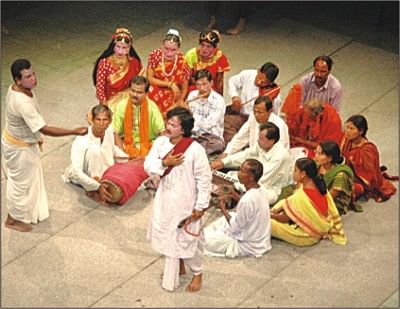Indigenous Performing Art Festival ends
'Ramayana' presented through 'Kushan Gaan'
Ershad Kamol
How aesthetically rich an indigenous performing art can be, was evident in the performance by Kripashindhu Roy and his troupe from Kurigram. Like the master director's best show, the troupe's presentation immensely moved the packed audience at the Experimental Theatre Stage at Bangladesh Shilpakala Academy. Roy's unique sense of proportion in art in the presentation amazed theatre activists and experts of Dhaka, who were present at the show on February 28. The troupe staged Ashameth Jagya section of the Ramayana through Kushan Gaan, an indigenous performing art form which is a balanced juxtaposition of dance, drama and music. It was the last show of the weeklong indigenous performing art festival arranged by the Department of Theatre and Film of Bangladesh Shilpakala Academy. The show began through the acoustics of dhol, bansi and harmonium, which was followed by the guru bandana by the choir. Later the gayen (lead singer) accompanied by a dohar and chhokras (boys dressed like girls) presented Ashameth Jagya part of the Ramayana, which features the final victory of Ramchandra over Ravan. The story ended with Ram's death in a combat against his two offspring Lab and Kush. Using the mythological story, artistes in Kushan Gaan advocate the welfare of human beings. So, improvisation featuring the contemporary time is another important aspect of the art form. And logically the use of chhokras in Kushan Gaan is not vulgar like the other shows in the festival. Rather, three chhokras artistically supported the gayen and singer during the narration. The speciality of the narration in Kushan Gaan is that the lead singer with the choir centering the instrumentalists at the middle of the stage makes circular movements from right to left. The smooth transition of the artistes from narration to music and acting and vice versa will remain firmly etched in the heart of the viewers. The use of effective contemporary comic relief and aphorisms during narration of a mythological story is mentionable. Another important aspect of the show was the use of popular folk music genre Bhawaiya in the performing art form. During the scene of Sita's search for her two sons Lab and Kush an actress presented a Bhawaiya not in baithaki but in a circular movement incorporating the aesthetic sentiment of pathos. The bold performance of Roy, especially his wonderful narration which had the power to create the sequences in mind of the audience as well as the power to transform from one character to another was moving. And Aynal's performance as Dohar, in diversified characters, was unique.
|

A colourful presentation by Kripashindhu Roy and his troupe. PHOTO: STAR |